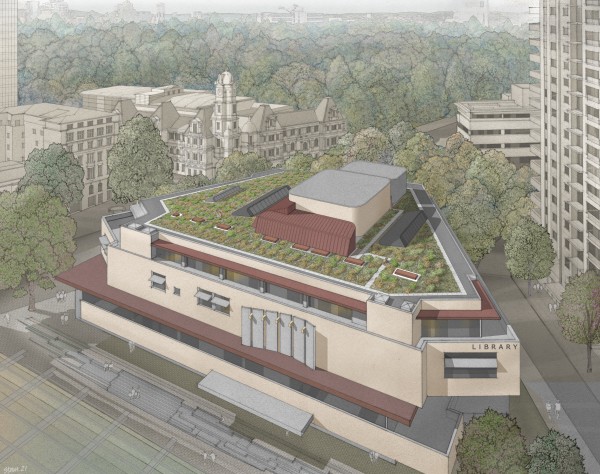Watch our highlights from the official opening
According to the United Nations Intergovernmental Panel on Climate Change, in 2020 cities were responsible for up to 72% of global greenhouse gas emissions, up from 62% in 2015.
Incorporating nature into the city landscape can help rein in those emissions by absorbing carbon and help meet Auckland Council’s target of reducing emissions by 50 per cent by 2030.
In response to delivering those climate change targets, a living ‘green roof’, a first for a council asset, has been installed on the central Auckland Library.
“Opportunities of this nature are rare. The library roof was undergoing planned remediation work, so leveraging the opportunity to install native plants as an alternative top layer to stone ballast, was a logical option to maximise on environmental benefits,” say Mayor Phil Goff.
“The Intergovernmental Panel on Climate Change says we only have around 10 years to reduce global carbon emissions to limit temperature rises to 1.5 degrees. We are already experiencing increasingly frequent and severe storms, floods, and prolonged dry periods, as well as impacts on biodiversity due to human induced climate change, so we must keep looking for opportunities to improve Auckland’s resilience and reduce our environmental footprint.
“Installing a living roof on the central library seemed an obvious choice and is one example of how we can visibly incorporate climate change considerations into our work programmes.”

Artist impression by stantiallstudio.co.nz
Local iwi, Ngāti Whātua Ōrākei, developed the roof design inspired by whāriki, a plaiting style of weaving representing the laying of foundations for all that it bears.
“You can see a pattern known as “poutama” which represents education, progress, and ascension. It pays homage to the library as a place where people seek education, progress and ascension into greater knowledge and understanding,” says Ngāti Whātua Ōrākei artist Hinengarangi Makoare.
“The pattern will change with time as the plants naturally establish their own balance depending on different species varying tolerances to the environment. This is an area where we need to let nature takes its course.”
Ngāti Whātua Ōrākei’s nursery propagated suitable native plant species for the exposed roof environment.
“Living roofs are becoming more desirable internationally due to the benefits they offer a city,” says Craig Mcilroy, General Manager Healthy Waters.
“Not only do they contribute to carbon dioxide reduction, but they also bring additional environmental, economic, and social wellbeing benefits. This might be providing better stormwater management; reduction in a building’s energy demand and increasing biodiversity opportunities in the city environs.
“A range of benefits will be monitored, reported on, and shared publicly, and we hope this will help others learn from this project and be inspired by living infrastructure,” he adds.
The project which has been plagued by COVID-19 delays, cost around $10 million for the remedial roof works with an additional $760,000 for the installation of the living roof.
A total of 2,050 low maintenance, hardy native plants have been planted in “eco-pillows” especially designed to incorporate a mix of soil and nutrients and prevent soil particles and sediment filtering into drainage systems and into the stormwater system. An additional 300 to 400 plants will be planted over the coming months to improve overall coverage.
Tom McCarthy, Natural Habitats Auckland Regional Manager says “we are thrilled to have used our eco-pillow system to bring Auckland City Library’s green roof to life. Eco-pillows are pillow shaped planters which are made of our unique growing media. The benefits of using eco-pillows are threefold. Eco-pillows are made from our ultra-lightweight growing media that primarily consists of recycled polystyrene collected from the city’s waste stream. This media makes eco-pillows ultra-lightweight requiring little to no structural changes to buildings, making green roofs affordable. The media mix we create is specially formulated to help pants thrive in their new habitat.”
Watch the coverage from Breakfast here.
-ENDS-
Editor notes:
560 permeable eco-pillows installed filled with low weight aggregate, pH values & nutrients
Native species planted include oioi, tātaraheke (sand coprosma), rengarenga, kowharawhara (coastal astelia), and Muehlenbeckia
Associated benefits include: reduction of urban heat island effect, increase in the life of the roof membrane (UV protection), improved air quality and insulation benefits
